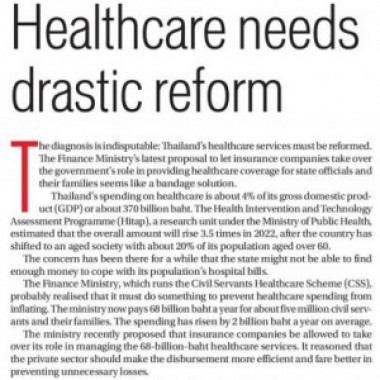HITAP Foundation รับรางวัลเกียรติยศ “5 ทศวรรษ ระบบยาประเทศไทย” พร้อมร่วมเสวนาทิศทางบัญชียาหลักแห่งชาติ



หนังสือพิมพ์: Bangkok Post
ฉบับวันที่: 11 ธันวาคม 2016

The diagnosis is indisputable: Thailand’s healthcare services must be reformed. The Finance Ministry’s latest proposal to let insurance companies take over the government’s role in providing healthcare coverage for state officials and their families seems like a bandage solution. Thailand’s spending on healthcare is about 4% of its gross domestic product (GDP) or about 370 billion baht. The Health Intervention and Technology Assessment Programme (Hitap), a research unit under the Ministry of Public Health, estimated that the overall amount will rise 3.5 times in 2022, after the country has shifted to an aged society with about 20% of its population aged over 60.
The concern has been there for a while that the state might not be able to find enough money to cope with its population’s hospital bills. The Finance Ministry, which runs the Civil Servants Healthcare Scheme (CSS), probably realised that it must do something to prevent healthcare spending from inflating. The ministry now pays 68 billion baht a year for about five million civil servants and their families. The spending has risen by 2 billion baht a year on average.
The ministry recently proposed that insurance companies be allowed to take over its role in managing the 68-billion-baht healthcare services. It reasoned that the private sector should make the disbursement more efficient and fare better in preventing unnecessary losses. The proposal is reportedly under study at present. Large insurance companies, however, have already expressed interest in joining the project. They said they could be ready to provide healthcare coverage for the civil servants as early as October next year. Members of the public and health practitioners do not appear as enthusiastic, however. An attempt at privatisation is often viewed with caution. Since this one concerns healthcare services, literally a matter of life and death for people, and a large sum of public money, it deserves to be considered with utmost care.
The point is not whether private insurance companies will be more efficient in providing the healthcare services than the government. Insurers interested in joining the programme pledged that they will have no problems meeting conditions imposed by the government, that healthcare benefits for state officials will be the same as they are now, that the quality of services must not deteriorate and total healthcare premiums must not exceed the current government’s spending on healthcare costs. The point is the civil servants healthcare scheme is just one of the country’s three main healthcare schemes, the smallest one in fact compared to the Social Security Fund (SSF), which caters to about 10 million private employees, and Universal Coverage (UC), which covers more than 49 million people. When it comes to efficiency, the government would do better addressing redundancies and inconsistencies both in terms of benefits, contributions and treatment among these three main healthcare schemes. For a start, the three healthcare schemes are governed by three different agencies: the Comptroller General’s Department of the Finance Ministry, the National Health Security Office of the Ministry of Public Health and the Social Security Office of the Ministry of Labour, which run the CSS, UC and SSF respectively.
According to a study on how to improve the country’s healthcare services by Thailand Development Research Institute (TDRI) in 2013, the administrative separation of the country’s healthcare schemes led to duplication of administrative costs and discrepancies in benefits under different schemes. The financial burden on members of the different schemes also differs. Members of the SSF have to pay monthly health insurance contributions which will be added up by the government and their employers while beneficiaries of the CSS and the UC obtain the services free of charge. There is no reason why these different healthcare schemes catering to different groups of population must be inequitable. This is on top of their being grossly inefficient because of the cumbersome administrative designs.
As suggested by the TDRI, the government should first make a decision about which healthcare model it will use as the national scheme. Since the UC covers the largest number of people and is viewed as being the most cost-efficient, the institute recommended that the scheme is the preferable candidate. Then there is a need to streamline management of the multiple schemes. The responsibility should fall on the Public Health Ministry, which is already in charge of the country’s health policies and healthcare providers through hospitals around the country. Healthcare benefits under the different schemes should be harmonised, with add-ons possible for additional charges. Most importantly, what is the point of having cost-efficient healthcare services if the public have no say in what they want from their healthcare providers or if the quality of services is not up to standard? That is why the TDRI is recommending that an independent agency composed of people from various sectors to monitor the budgetary and service quality of all healthcare schemes should work to ensure transparency and keep conflicts of interest at bay. The country’s healthcare services are in need of an overhaul. That is why the Finance Ministry’s proposal of having private insurance firms run its scheme for civil servants is but a piecemeal effort that is unlikely to address the real issue.